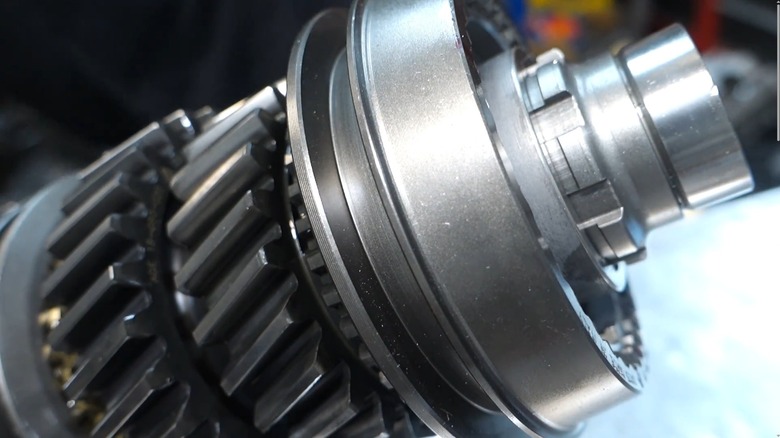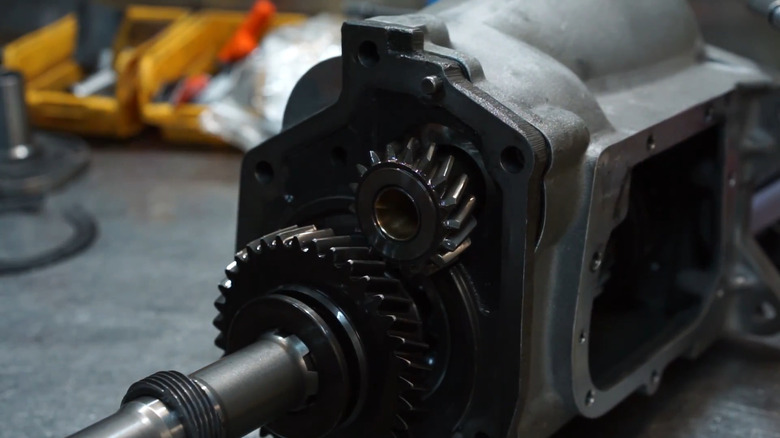Why Is The Muncie M22 Transmission Called The 'Rock Crusher?'
The Muncie M22 "Rock Crusher" is one of the most well-known manual transmissions available in classic cars. Named after its place of origin (Muncie, Indiana), this four-speed is the final iteration of the Muncie 20-series lineup used in GM muscle cars, namely the M20, M21, and M22. What makes the M22 in particular so special is that it's incredibly overbuilt, utilized on many high-torque applications dating back to the one of the rarest Corvettes ever, the Grand Sport, and its testing program. The Rock Crusher debuted on the production 1965 Corvette and then came to other platforms in the mid-late 1960s. Before long, it equipped a variety of iconic GM big block engines powering Chevelles, Trans Ams, and more.
Rock Crushers' distinctive whine in lower gears, similar to a true straight-cut gearbox, makes M22-equipped cars immediately noticeable. It's also what lends the transmission its incredible reputation. GM essentially traded comfort for durability, with the design of the gears and other components favoring strength over quietness and refinement. It would rattle around at low RPM and produce that whine at an increasing pitch the faster the shaft spun, sort of like an old truck transmission. This gave rise to the moniker "Rock Crusher," though people continue to speculate precisely who coined the name.
Let's tear apart an M22 to get a true sense of why the transmission sounds the way it does, and learn the story of the Muncie, leading up to the infamous "Rock Crusher" and what replaced it.
Earning the Rock Crusher nickname
The secret to what makes the M22 so strong lies in two factors: the construction of the transmission itself and the cut of the gears. They're not a true straight-cut like a racing transmission or sequential manual with a dog-box; rather, they simply feature a more shallow helical cut than the M20 or M21. This is important because the shallower a gear is cut, the more noise it'll produce. Straight-cut gearboxes are typically only found in race cars and modified road cars for this reason. Couple that with the fact that the gears themselves are wider than the standard M20 or M21, and you've just got more metal generating noise as you drive along.
Other than the gears themselves, the transmission itself is essentially a heavily beefed up M20/M21 (their main differentiating factor is the gear ratio, with the M20 having a wider ratio than the M21). Unlike these transmissions, the M22 utilizes various methods to improve its structural durability, such as a stronger alloy in its input shaft, 1-inch countershaft support (as opposed to ⅞-inch on M20), and higher nickel content in the gears. The M22 came with either a 10-spline input and 27-spline output (early models), or 26-spline input and 32-spline output shafts (1970-1974), though the shafts themselves were also upgraded to handle the additional torque output. So while all Muncie M20-series transmissions featured a combination of these shafts, they aren't strictly interchangeable with the M22's.
The M22's legacy
The M20-series as we know it today actually derives its basic design from the older Borg-Warner T10, which itself traces its lineage back to 1957. Essentially, the Muncie represents a variant of the T10, just scaled up to the point where it'll handle 400 lb-ft torque (though owners report varying levels of success, with some casings seemingly dealing with 500-plus with no issue). M22 Rock Crushers are still available and handle enough torque to comfortably accept factory small block and big block muscle power, and they remain popular enough that rebuilt units typically sell for around a few thousand bucks on sites like eBay.
As for why GM halted production, that's largely left to speculation, since the company never put out any readily available official statement. However, 1974 marked the first extended model year following the first Oil Crisis, which left manufacturers scrambling to build smaller, more fuel-efficient cars; this era effectively led to the demise of classic muscle cars like the the iconic Chevrolet Impala. As such, with a lack of powerful cars like the Chevelle SS 454 and Pontiac Trans Am Super Duty 455, there wasn't really much point in continuing production of a noisy, unrefined, and ultimately niche transmission.
However, the T10 remained in-production well beyond the M22's demise, equipping performance GMs well into the 1980s. The platform itself is so robust and timeless that even today you can find a brand-new T10 4-speed manual transmission, produced by Richmond Gear, via outlets like Summit Racing.


